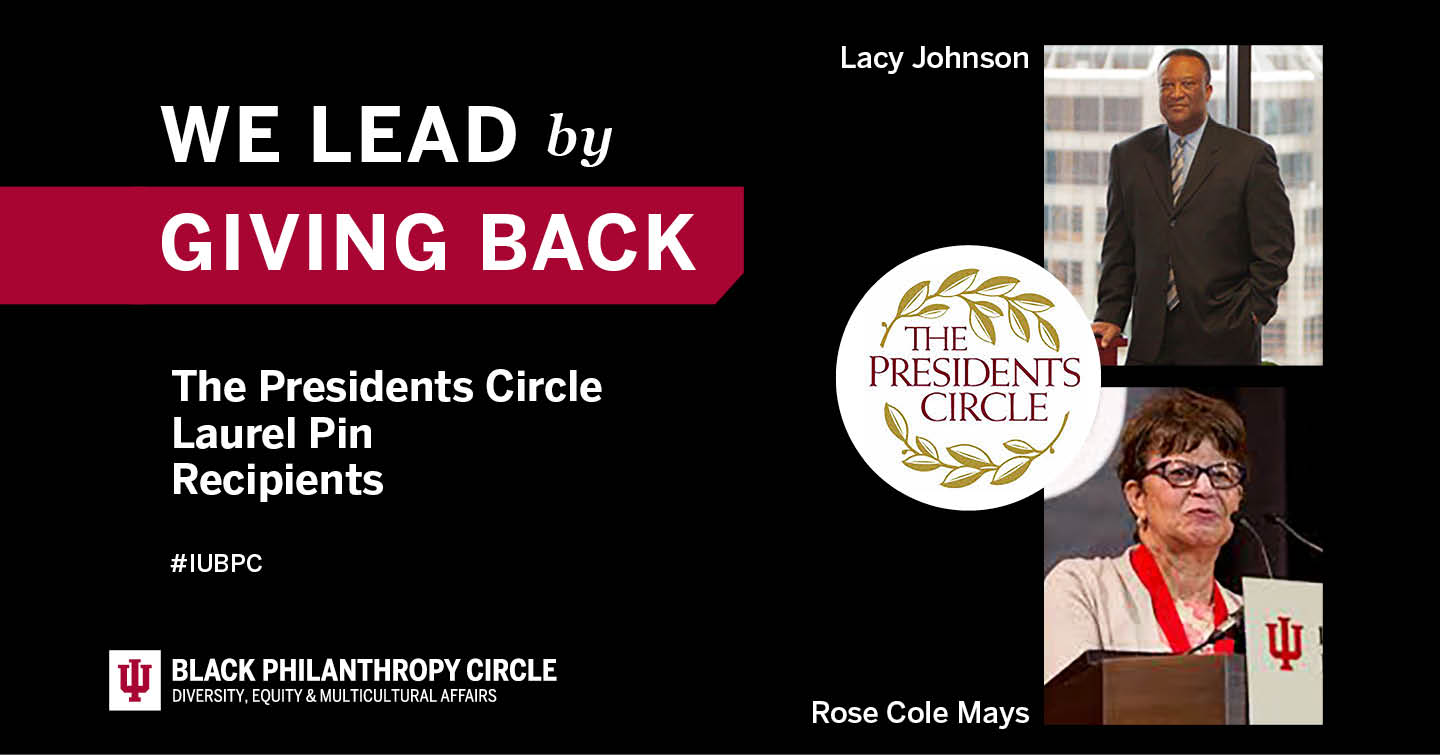At its core, philanthropy is the intersection between two forces: a love for an institution and the relationships it cultivates, and a driving ambition to pay one’s success forward to the next generation. This is especially true for Rose Cole Mays and Lacy Johnson, two longtime African American supporters of Indiana University whose passions for the university are only matched by their hopes to make it an even more inclusive and diverse environment in the future.
This year, Mays and Johnson, along with Johnson’s wife, Patricia, became the first African Americans awarded the Indiana University Presidents Circle Laurel Pin. An award recognizing cumulative giving of more than $1 million to the university, the Laurel Pin is a small symbol of Mays’ and Johnson’s dedication to Indiana University--a dedication grounded in their commitment to diversity and inclusion, as well as the relationships built in their decades of engagement with IU.
“When we attended the event where the pin was actually awarded, it also emphasized and highlighted how many others had also given at that level and even higher levels. It was quite humbling, and we really appreciated the honor,” Mays said.
The philanthropic efforts of Mays and Johnson have affected many areas of life at IU. They both serve as members of the newly created Black Philanthropy Circle, a group for which Mays also serves as interim co-chair. Announced during Black Philanthropy Month, the Black Philanthropy Circle will help raise and direct giving to campus initiatives that improve the experiences and retention of Black students, faculty, and staff--key causes for both Johnson and Mays.
In addition to their involvement with the Black Philanthropy Circle, Johnson and Mays have given extensively to other causes on IU’s campuses. The first official gift of the Black Philanthropy Circle will support the Mays Family Institute on Diverse Philanthropy at IU Indianapolis, an institute named in honor of Mays and her late husband, William. Both the Johnsons and Mays provided initial funding for the Institute to study the relationship between philanthropy and historically underserved communities. Responding to a lack of university chairs endowed or occupied by African Americans, Johnson has also been active in giving to Indiana University by endowing the Johnson Chair for Diversity and Leadership with a $1.5 million gift. James C. Wimbush, vice president for Diversity, Equity, and Multicultural Affairs and dean of The University Graduate School, is the first recipient of the endowed chair.
Reflecting on their giving, both Johnson and Mays stressed the many relationships with members of the IU community that made their gifts possible. They also expressed hope in the power of philanthropy to help students from all underserved communities.
“It really goes back to the encouragement, the support, and the opportunities that Bill and I were given,” Mays said.
Mays’ connection with Indiana University began when she attended IU Indianapolis to earn her master’s degree in nursing. Once she graduated, the school invited her to return as a professor in the nursing program, where she taught until her retirement in 2009. From her years as a student to the decades she spent on the university’s faculty, the welcoming environment she encountered as an African American inspired Mays.
“At that time, African Americans were not particularly embraced or included, they were more or less tolerated [in society], if you will… but we really had excellent professors and colleagues that really encouraged us,” Mays said.
Johnson, now a partner at Ice Miller in Indianapolis, also found a supportive network of colleagues, faculty, and staff when he attended Indiana University’s Robert H. McKinney School of Law. Through his time at the university, Johnson met individuals like late longtime Trustee Danny Danielson, former president of the IU Foundation Curt Simic, and IU Trustee Jim Morris, all of whom inspired his involvement with the university after graduation. Johnson’s background, which he described as the result of investment of time and resources from his family, teachers and leaders in his church, also helped motivate his giving.
“All of those individuals were providing something for children they didn’t even know. And if it wouldn’t have been for those philanthropic and volunteer activities, there’s no doubt I wouldn’t have been provided some of the opportunities that I got,” Johnson said. “I felt compelled to carry that forward and to provide those opportunities for other less [financially] fortunate individuals such as myself.”
Such philanthropic gifts are not only the story of generous individuals like Mays and Johnson. They also point to the work of people like Joyce Q. Rogers, vice president for Development and External Relations for Diversity, Equity, and Multicultural Affairs at the Indiana University Foundation. When donors like Johnson and Mays decide to give to an OVPDEMA-supported cause, Rogers works with them to identify the ways to maximize the impact of their philanthropic giving. With the goal of directing more philanthropic initiatives to support diversity and inclusion on IU’s campuses, Rogers has increased OVPDEMA’s fundraising work and connections with the IU Foundation. More recently, Herb Caldwell, OVPDEMA director of Development and External Relations and Roberta Radovich, manager of Development, Marketing, and Communications, began working with Rogers on these efforts.
In carrying out this work, Rogers and her team maintain the relationships that ensure that gifts like Mays’ and Johnson’s will impact the IU community for years to come.
“One of the key things I’ve learned is, when you really think about it, it’s about economics,” Rogers said. “And education changes economics. It doesn’t just change that person, it changes generations.”


